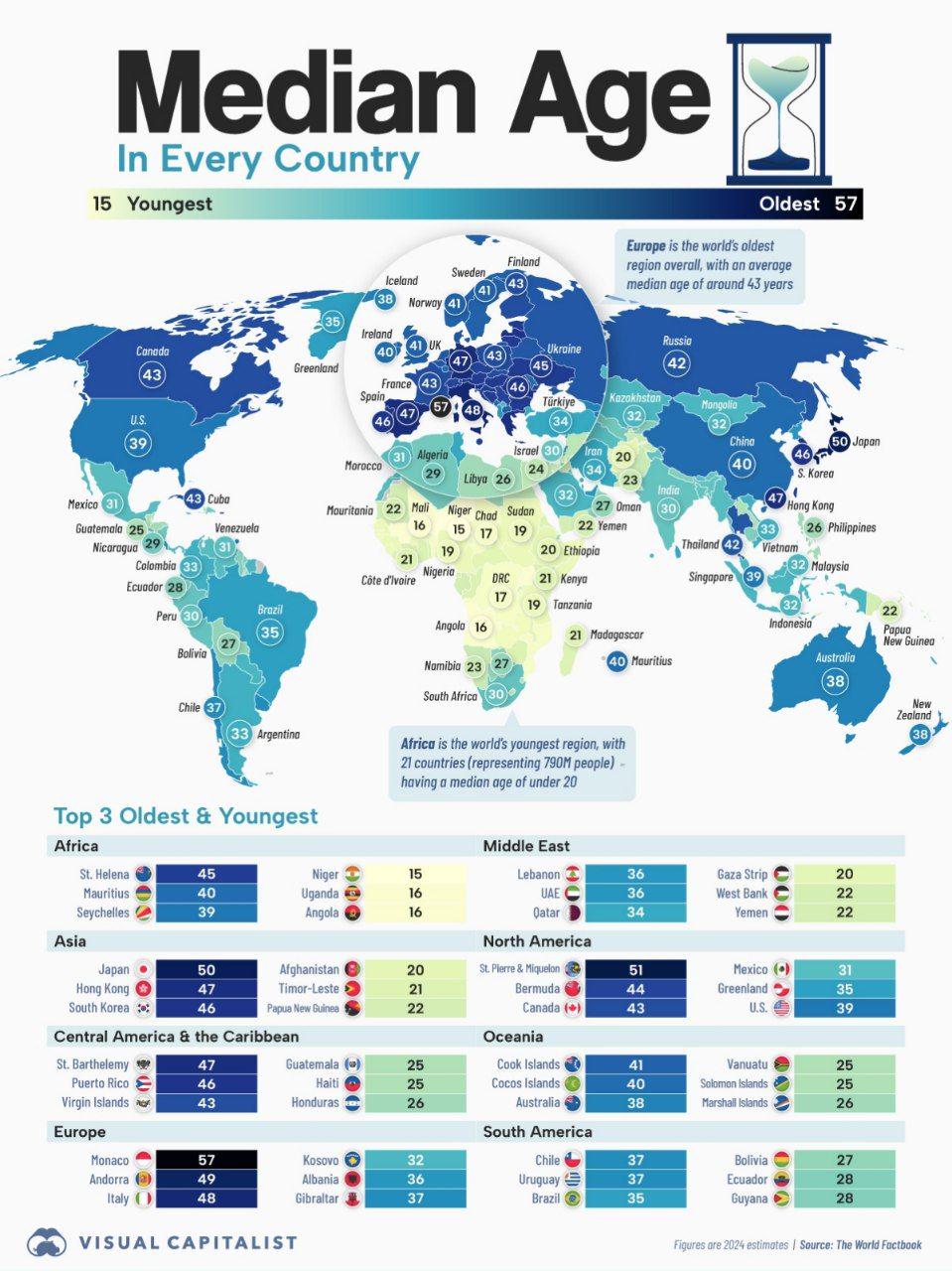Median Age by Country Map


Alex Cartwright
Senior Cartographer & GIS Specialist
Alex Cartwright is a renowned cartographer and geographic information systems specialist with over 15 years of experience in spatial analysis and data...
Geographic Analysis
What This Map Shows
The 'Median Age by Country Map' provides a visual representation of the median age across different nations. This visualization highlights the age distribution in various countries, giving us insight into demographic trends and population dynamics. The median age is a crucial indicator that reflects the age structure of a population, influencing everything from economic growth to social services. It tells us how old, on average, the residents of a country are, and hints at the challenges and opportunities that come with different age distributions.
Deep Dive into Median Age
Median age is more than just a number; it encapsulates the demographic profile of a country. It is defined as the age that divides a population into two equal halves, where half of the population is younger and the other half is older. This statistic is vital for understanding a population's age composition, which can significantly affect a country’s economic performance, healthcare needs, and social policies.
Interestingly, countries with a younger median age, such as Niger and Uganda, often have high birth rates and rapidly growing populations. In contrast, nations like Japan and Germany, with much older median ages, are grappling with declining birth rates and aging populations. This demographic shift can lead to a range of challenges, including labor shortages and increased healthcare costs.
Demographically, the world is witnessing a trend towards aging populations, especially in developed countries. For instance, Japan’s median age is around 48 years, and this has significant implications for its economy. As the population ages, there are fewer individuals in the workforce, which can slow economic growth and increase the dependency ratio. This means that for every working-age person, there are more elderly individuals requiring care and support.
Moreover, the median age can influence cultural and social structures. Younger populations may be more open to change and innovation, while older populations might prioritize stability and tradition. This can affect everything from consumer behavior to political landscapes.
To illustrate, in countries like Nigeria, where the median age is around 18 years, the youthful population drives vibrant cultures and entrepreneurial ventures. Conversely, in countries such as Italy, with a median age of around 47 years, there is a stronger focus on preserving cultural heritage and managing an aging population's needs.
Regional Analysis
When we break down median ages by region, some interesting patterns emerge. In Africa, the median age is notably low, often under 20 years. This youth bulge suggests significant potential for growth but also poses challenges in terms of providing education, jobs, and healthcare.
In North America, the median age is higher, hovering around 38 years. The United States, for example, has a median age of about 38.5 years, reflecting its diverse demographics and immigration trends. Interestingly, Canada has a slightly higher median age, which can be attributed to its well-established healthcare system and higher life expectancy.
In Europe, the trend of aging populations is evident, with countries like Germany and Italy having median ages of 47 and 46, respectively. These nations are facing unique challenges, such as labor market constraints and the need for policies that support older citizens. In contrast, Eastern European countries generally have lower median ages compared to their Western counterparts, reflecting different historical and socio-economic factors.
Asia presents a mixed picture; on one hand, countries like India have a youthful median age of around 28 years, while others like Japan and South Korea have much older populations, emphasizing the continent's diversity in demographic trends.
Significance and Impact
Understanding median age is crucial for policymakers, businesses, and social planners. For governments, this information is vital for crafting policies that address the needs of their populations. Countries with aging populations must consider retirement funding, healthcare services, and immigration policies to balance workforce needs.
Moreover, businesses can use median age data to tailor their products and services. A younger population might demand tech-savvy solutions and innovative products, while an older demographic may prioritize health and wellness offerings.
Current trends suggest that the global median age is steadily increasing, reflecting improvements in healthcare and living standards. Projections indicate that by 2050, many countries will see significant shifts in their age structures, with aging populations becoming the norm in developed nations.
In conclusion, the 'Median Age by Country Map' is not just a collection of numbers; it is a window into the socio-economic fabric of nations. By understanding the implications of median age, we can better prepare for the future and meet the challenges that arise from our changing demographics.
Visualization Details
- Published
- October 21, 2025
- Views
- 24
Comments
Loading comments...